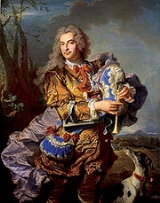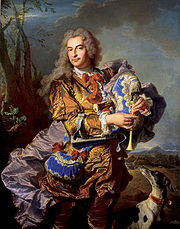
Musette de cour
Encyclopedia

Double reed
A double reed is a type of reed used to produce sound in various wind instruments. The term double reed comes from the fact that there are two pieces of cane vibrating against each other. A single reed consists of one piece of cane which vibrates against a mouthpiece made of metal, hardened...
, giving a quiet tone similar to the oboe
Oboe
The oboe is a double reed musical instrument of the woodwind family. In English, prior to 1770, the instrument was called "hautbois" , "hoboy", or "French hoboy". The spelling "oboe" was adopted into English ca...
. The instrument is always bellows-blown.
Note: the qualified name de cour does not appear in original music for the instrument; title-pages refer to it simply as musette, allowing occasional confusion with the piccolo oboe
Piccolo oboe
The piccolo oboe, also known as the piccoloboe, is the smallest and highest pitched member of the oboe family, historically known as the oboe musette...
.
History
First appearing in FranceFrance
The French Republic , The French Republic , The French Republic , (commonly known as France , is a unitary semi-presidential republic in Western Europe with several overseas territories and islands located on other continents and in the Indian, Pacific, and Atlantic oceans. Metropolitan France...
, at the very end of the sixteenth century, the musette was refined over the next hundred years by a number of instrument-making families. The best-known contributions came from the Hotteterre family: Martin Hotteterre added a second chanter, the petit chalumeau, extending the instrument's range by six semitones. The bourdon, originally designed to accompany essentially modal music, became simpler as the chalumeaux became more complicated. The final form of the musette is fully chromatic, with a range of an octave and half starting from F above middle C; the bourdon provides drones for C, D and G.
The qualification de cour refers to the instrument's connection with the French court and aristocracy of the early seventeenth century. "Exotic" - in the sense of imported or out of place - elements were fashionable, resulting in the appearance of traditional instruments such as bagpipe, hurdy-gurdy and galoubet
Galoubet
Galoubet may refer to:* Galoubet A, a show jumping horse* A type of Pipe...
in compositions for professionals and amateurs alike. The musette may well have benefited from being a bellows-blown instrument, too; it was generally considered unseemly for women to play any mouth-blown instrument. Borjon de Scellery, however, does explicitly identify grimacing and pulling faces as a habit of ill-trained musette-players.
At the height of its popularity, the musette (like the hurdy-gurdy) was used not just for chamber-music but also in larger-scale compositions such as operas, where it was associated with shepherds, peasants and other pastoral
Pastoral
The adjective pastoral refers to the lifestyle of pastoralists, such as shepherds herding livestock around open areas of land according to seasons and the changing availability of water and pasturage. It also refers to a genre in literature, art or music that depicts such shepherd life in an...
elements. After the French Revolution
French Revolution
The French Revolution , sometimes distinguished as the 'Great French Revolution' , was a period of radical social and political upheaval in France and Europe. The absolute monarchy that had ruled France for centuries collapsed in three years...
, the musette seems to have fallen rapidly out of favour while simpler forms of bagpipe remained popular as folk-instruments. As a result, musicologists examining French baroque music at the end of the 19th century found it difficult to imagine that what they took to be the same as a simple folk bagpipe could ever have had a place in highly sophisticated music for the court.
The "authentic performance" approach generally familiar from the 1970s onward, plus skillful restoration of original instruments by makers such as Rémi Dubois (Verviers, Belgium), has made it possible to hear works such as Chédeville
Nicolas Chédeville
Nicolas Chédeville was a French composer, musette player and musette maker.-Biography:He was born in Serez, Eure; musicians Pierre Chédeville and Esprit Philippe Chédeville were his brothers. Louis Hotteterre was his great uncle and godfather, and may have given him instruction in music and...
's "Pastor Fido" (based on Vivaldi
Antonio Vivaldi
Antonio Lucio Vivaldi , nicknamed because of his red hair, was an Italian Baroque composer, priest, and virtuoso violinist, born in Venice. Vivaldi is recognized as one of the greatest Baroque composers, and his influence during his lifetime was widespread over Europe...
's "Seasons"), chamber-music by Boismortier
Joseph Bodin de Boismortier
Joseph Bodin de Boismortier was a French baroque composer of instrumental music, cantatas, opéra-ballets, and vocal music...
and even Rameau
Jean-Philippe Rameau
Jean-Philippe Rameau was one of the most important French composers and music theorists of the Baroque era. He replaced Jean-Baptiste Lully as the dominant composer of French opera and is also considered the leading French composer for the harpsichord of his time, alongside François...
's opéra-ballet "Les Fêtes d'Hébé" in their original form.
Chalumeaux (chanters)
The frontispiece in Borjon de Scellery's Traité (1672) shows a shepherd surrounded by a number of instruments. They include an early musette, with a single chalumeau that appears to have six finger-holes and no keys. The first full-page plate then illustrates a chalumeau with seven finger-holes and three keys, giving a range of one octave.The second full-page plate illustrates a more developed form of the musette, where a grand chalumeau with five keys is complemented by a petit chalumeau with six keys. Jacques Hotteterre's Méthode (1738) illustrates the most usual final form of the instrument; the six-key petit chalumeau is the same as de Scellery's, but the grand chalumeau now has seven keys.
The petit chalumeau, as already mentioned, was added by Martin Hotteterre; though physically connected to the grand chalumeau, and sharing the same wind-supply from the bellows, it has its own double reed and functions as a separate instrument. The lowest note on the petit chalumeau is an A flat a semi-tone below the higher A on the grand chalumeau, and keeping the two chalumeaux in tune and in balance is one of the difficulties of the instrument.

Bourdons (drones)
Following the principle of the rackettRackett
The rackett is a Renaissance-era double reed wind instrument.There are several sizes of rackett, in a family ranging from soprano to great bass. Relative to their pitch, racketts are quite small . This is achieved through its ingenious construction...
and the bassoon
Bassoon
The bassoon is a woodwind instrument in the double reed family that typically plays music written in the bass and tenor registers, and occasionally higher. Appearing in its modern form in the 19th century, the bassoon figures prominently in orchestral, concert band and chamber music literature...
, the short cylinder of the musette drone contains airways that double back on themselves. Openings in each airway (the equivalent of finger-holes) are uncovered by moving layettes (sliders) fixed in four coulisses (runners). The two lowest notes use the same airway, so cannot be played together.
The earliest musettes had up to nine coulisses and twelve layettes, so that you could play music in a range of modes and always have a drone using the home-note of the mode. As the chalumeaux developed and became fully chromatic, so it became possible to play music in different modes but starting on the same note; fewer possible drone-notes were needed, and the bourdon was simplified. Even so, the bourdon still contains four or more separate reeds that have to be kept adjusted and in tune.
Repertory
The musette was an instrument both for professionals, members of ensembles and orchestras in the court or noble households, and for amateurs. As a result, the music written for the instrument ranges from simple transcriptions of popular tunes – folk-dances in Borjon de Scellery's Traité, songs from current operas in Hotteterre's Méthode – to quite demanding pieces by the best-known composers of the day. The bulk of music written for the musette is not solo music; duos are the most popular form, followed by trio-sonatas. Much of the music available for the instrument was described as suitable for musette, hurdy-gurdy, recorder or transverse flute; or for all these plus oboe or violin. Modern editions, usually for recorder, give people the chance to discover a lot of musette music, though it needs the drone(s) to be heard as the composer intended.Composers (in alphabetical order) include Bâton, Boismortier
Joseph Bodin de Boismortier
Joseph Bodin de Boismortier was a French baroque composer of instrumental music, cantatas, opéra-ballets, and vocal music...
, Buterne, Chédeville
Nicolas Chédeville
Nicolas Chédeville was a French composer, musette player and musette maker.-Biography:He was born in Serez, Eure; musicians Pierre Chédeville and Esprit Philippe Chédeville were his brothers. Louis Hotteterre was his great uncle and godfather, and may have given him instruction in music and...
(l'Ainé and le Cadet), Corrette
Michel Corrette
Michel Corrette was a French organist, composer and author of musical method books.-Life:Corrette was born in Rouen, Normandy. His father, Gaspard Corrette, was an organist and composer. Corrette served as organist at the Jesuit College in Paris from about 1737 to 1780. It is also known that he...
, Delavigne
Philibert Delavigne
Philibert Delavigne was a French composer.Little is known of his life, except that he was active at the court of Louis XV and entered the service of the Comte d'Ayen around 1730.Only three sets of compositions by Delavigne survive:...
, Hotteterre "le Romain"
Jacques-Martin Hotteterre
Jacques-Martin Hotteterre , also known as Jacques Martin or Jacques Hotteterre, was a French composer and flautist. Jacques-Martin Hotteterre was the most celebrated of a family of wind instrument makers and wind performers.-Biography:Jacques-Martin Hotteterre was born in Paris, the son of Martin...
, Naudot
Jacques-Christophe Naudot
Jacques-Christophe Naudot was a French composer, type-setter, and flutist. Little is known of his early life. He was married in 1719. Most of his compositions were published in Paris between 1726 and 1740. The poet Denesle wrote a book called "Syrinx, ou l'origine de la flutte"...
, and Rameau
Jean-Philippe Rameau
Jean-Philippe Rameau was one of the most important French composers and music theorists of the Baroque era. He replaced Jean-Baptiste Lully as the dominant composer of French opera and is also considered the leading French composer for the harpsichord of his time, alongside François...
. Interest in the musette seems to have been confined almost exclusively to French composers, though the tranquil dance-form with the same name is more widespread. There are both Lyra (hurdy-gurdy) and Musette movements in Telemann orchestral suites, for example, and a Musette in the Anna Magdalena Bachbüchlein
Notebook for Anna Magdalena Bach
The title Notebook for Anna Magdalena Bach refers to either of two manuscript notebooks that the German Baroque composer Johann Sebastian Bach presented to his second wife Anna Magdalena...
.
The Traité by Borjon de Scellery, while mentioning the petit chalumeau and including it in the illustrations, concentrates on the grand chalumeau and includes [mostly] dance-tunes and popular songs in its examples. The Méthode by Hotteterre covers the full range of the developed form of the instrument, and as well as examples taken from popular operas includes a number of original compositions designed to extend the player's skill in specific areas. Both these works also teach how to read music, de Scellery providing examples in standard notation and in musette tablature
Tablature
Tablature is a form of musical notation indicating instrument fingering rather than musical pitches....
, and advice on basic maintenance. It is clear that they are expecting their readers to live in Paris or one of the largest provincial towns, where they will readily find instrument-makers and tutors to help them.
Further reading
- The musette page on Oliver Seeler's site the Universe of Bagpipes
- Naoki Ueo's Musette de cour site

